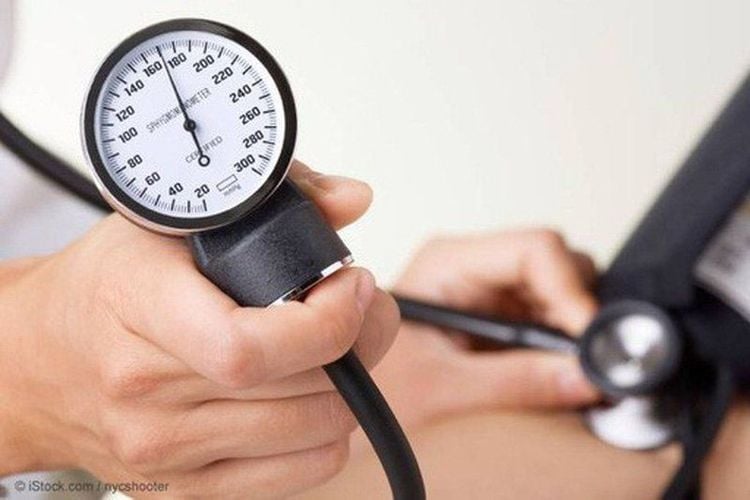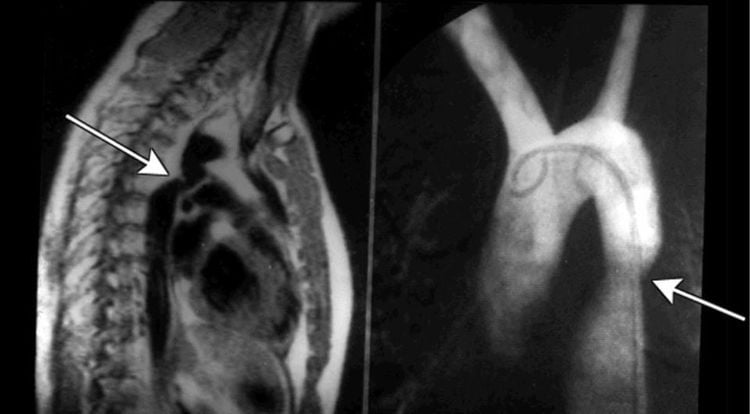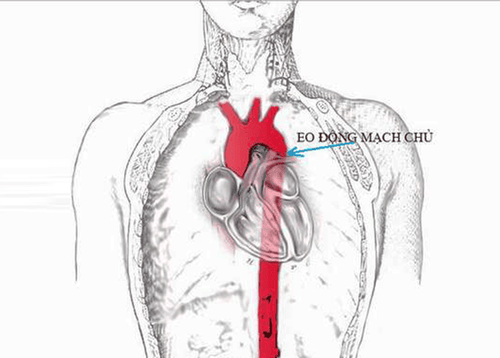This is an automatically translated article.
The article is professionally consulted by Master, Doctor Nguyen Tung Hoanh - Interventional Cardiologist - Department of Resuscitation - Emergency - Vinmec Nha Trang International General Hospital.Hypertension due to coarctation of the aorta is a form of hypertension secondary to congenital disease of the coarctation of the aorta. Coarctation of the aorta accounts for 5-8% of congenital heart diseases.
1. What is coarctation of the aorta?
Coarctation of the aorta is a narrowing of the aorta across the isthmus, which is the predominant form of aortic stenosis. It is often described in relation to the location of the ductus arteriosus. Coarctation of the aorta can be anterior to the ductus arteriosus, at the ductus arteriosus or posterior to the ductus arteriosus.
The disease can occur at all ages, accounting for 5-8% of congenital heart diseases. Coarctation of the aorta may have a fold pattern, also known as a lumbar lesion, a diaphragmatic lesion, or a tubular lesion due to partial aortic hypoplasia.
2. Pathogenesis of hypertension due to coarctation of the aorta
Hypertension occurs in many patients with coarctation of the aorta. However, the explanation of the mechanism causing hypertension is still controversial because it is not simply due to mechanical obstruction.
There are 3 reasons explaining the increase in blood pressure in coarctation of the aorta mentioned, which are mechanical factors (obstruction increases vascular resistance), neurological factors (obstruction changes the blood pressure). carotid pressure induction) and renal factor (renal ischemia).
Paroxysmal hypertension occurring within 1 week of surgical repair of coarctation of the aorta, also known as rebound hypertension, is thought to be secondary to sympathetic hyperactivity and reflex vasoconstriction. distal responses as well as increased renin activity.

Tăng huyết áp do hẹp eo động mạch chủ
3. Clinical forms of coarctation of the aorta
Coarctation of the aorta leads to hypertension characterized by a difference in blood pressure in the upper and lower extremities (normally the lower extremity blood pressure is higher than the upper extremity, in this case the opposite). Over time, the left ventricle enlarges to accommodate the increased afterload, which gradually leads to chamber dilation and heart failure.
3.1. In infants and young children This is an early manifestation of coarctation of the aorta, commonly seen in pre-ductal coarctation of the aorta, with a severe clinical picture. These children have a ductus dependent circulation, when the ductus arteriosus is shut off, the perfusion of the lower body will cease and lead to vascular collapse. Once the inguinal pulse is weak, a significant difference in upper and lower extremity blood pressure is suggestive of coarctation of the aorta in the neonate. The study by Crossland et al recorded that upper extremity blood pressure > lower extremity blood pressure 20mmHg has a diagnostic value of coarctation of the aorta with a sensitivity of 92% 3.2. In older children and adults This is a late manifestation of coarctation of the aorta, seen in older children or adults with upper extremity hypertension and an audible murmur in the left sternal second intercostal space, or on the left side. back due to blood flowing through the narrowing.
Very high blood pressure with a difference in blood pressure in the upper and lower extremities. Hypertension usually appears after 15 days of age. After the age of 15, your blood pressure usually becomes fixed and won't go down even if the cause is addressed. The inguinal pulse is weak and may not be detected in severe cases. The systolic murmur is in the left subclavian region, possibly spreading posteriorly to the paravertebral position. Should measure blood pressure of both arms and legs to compare, in addition to the phenomenon of blood pressure in the upper extremities higher than the lower extremities, in some cases, blood pressure in the right arm may be higher than the left arm when the narrow area spreads down to the origin of the artery. Left subclavian, or conversely, left arm blood pressure higher than right arm, is seen in a small number of cases where the right subclavian artery originates anomalously in the distal part of the coarctation of the aorta.
4. Diagnosis of coarctation of the aorta
Chest X-ray: May be normal, in classic cases can see 3-arc sign in aorta, rib impression. Electrocardiogram: Detects signs of left ventricular hypertrophy, but it does not allow diagnosis. Doppler echocardiography: Often useful in young children, in adults it is more difficult to evaluate. On ultrasound, it is possible to determine the location of the stenosis, measure the pressure gradient across the aortic isthmus, detect congenital abnormalities such as mitral aortic valve, left ventricular outflow tract obstruction, stenosis. mitral ... Computed tomography of the aorta: As a decisive means of diagnosing coarctation of the aorta in adults. On radiographs, the location, stenosis morphology, collateral circulation and associated lesions were identified. Diagnostic cardiac catheterization: Insertion of instruments through a peripheral vascular route (femoral or radial artery) to image the narrowing and collateral circulation. Coarctation of the aorta is diagnosed when the pressure difference is greater than 10 mmHg between the ascending aorta and the descending aorta. However, the gradient does not reflect the degree of stenosis because it may be influenced by collateral circulation.

Chẩn đoán hẹp eo động mạch chủ dựa trên X-quang
5. Coarctation of the aorta
Depending on the clinical form of coarctation of the aorta, there is an appropriate management attitude. For cases with early and severe manifestations in neonates, it is necessary to use prostaglandin E1 infusion to reopen the ductus arteriosus, at the same time, actively resuscitate to stabilize the patient and perform emergency surgery to repair the narrowing and restore circulation. through the narrow.
Treatment of ductus arteriosus is mainly surgical, but in emergency cases can be temporarily treated with some drugs. Mild cases of coarctation of the aorta can adapt to life without surgery. Therefore, surgery is indicated for patients with pressure difference between upper and lower extremities >20 mmHg at rest or stenosis >50% of arterial diameter.
Coarctation of the aorta is an easily missed diagnosis. Measurement of blood pressure and pulse in both upper and lower extremities are essential measures in clinical examination. Surgery had good results. Balloon dilation should be performed in centers with conditions.
As a key area of Vinmec Health system, Pediatrics Department always brings satisfaction to customers and is highly appreciated by industry experts with:
Gathering a team of leading pediatric doctors and nurses : consists of leading experts with high professional qualifications (professors, associate professors, doctorates, masters), experienced, worked at major hospitals such as Bach Mai, 108.. Doctors All doctors are well-trained, professional, conscientious, knowledgeable about young psychology. In addition to domestic pediatric specialists, the Department of Pediatrics also has the participation of foreign experts (Japan, Singapore, Australia, USA) who are always pioneers in applying the latest and most effective treatment regimens. . Comprehensive services: In the field of Pediatrics, Vinmec provides a series of continuous medical examination and treatment services from Newborn to Pediatric and Vaccine, ... according to international standards to help parents take care of their baby's health from birth to childhood. from birth to adulthood Specialized techniques: Vinmec has successfully deployed many specialized techniques to make the treatment of difficult diseases in pediatrics more effective: neurosurgery - skull surgery, stem cell transplantation. blood in cancer treatment. Professional care: In addition to understanding children's psychology, Vinmec also pays special attention to the children's play space, helping them to have fun and get used to the hospital's environment, cooperate in treatment, improve the efficiency of medical treatment. MSc. Nguyen Tung Hoanh has experience and strength in Cardiovascular Resuscitation - Emergency: Hypertension, Peripheral Vascular Diseases, acute and chronic coronary artery diseases, ..in addition, the doctor also treats other diseases. Comorbidities such as: Diabetes, Hyperthyroidism, Hypothyroidism, Kidney diseases, respiratory diseases, etc. Currently, Dr. Hoanh is an interventional cardiologist at the Department of Resuscitation - Emergency - Vinmec Nha Trang International General Hospital.
Please dial HOTLINE for more information or register for an appointment HERE. Download MyVinmec app to make appointments faster and to manage your bookings easily.
Source: Vietnam Journal of Cardiology












